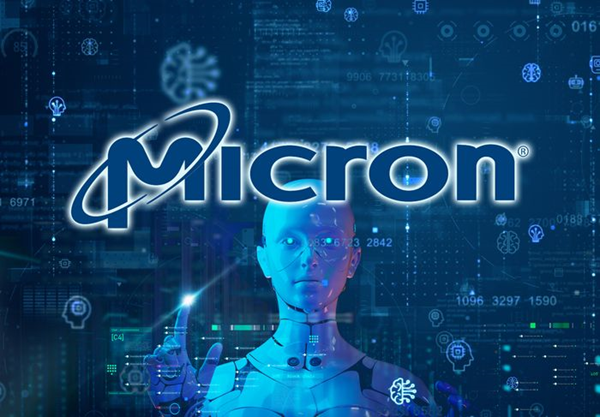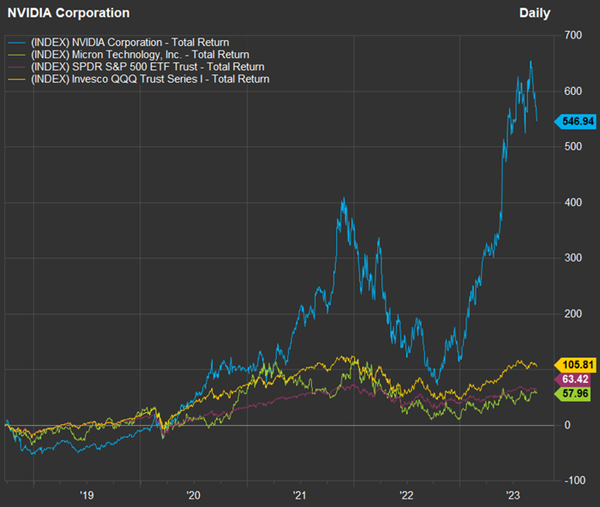Deep Dive
Micron’s stock might be an excellent play for AI investors who want to
diversify beyond Nvidia
Last
Updated: Sept. 22, 2023 at 8:07 a.m. ET
First Published: Sept. 21, 2023 at 12:39
p.m. ET
—
By Philip
van Doorn
High prices for Nvidia’s GPUs may be
unsustainable. Meanwhile, Micron’s new high-bandwidth memory chips
could offer stickier pricing and propel its recovery.
|

MARKETWATCH PHOTO ILLUSTRATION/ISTOCKPHOTO
|
Investors have shown their enthusiasm for artificial intelligence this
year by sending shares of Nvidia Corp. on a rocket ride. But there are
other hardware companies selling products that are used by data
centers every time an Nvidia graphics processing unit is installed.
And the rollout of new high-bandwidth memory technology next year
could provide a boost for Micron Technology Inc. This could be an easy
way for U.S. investors to take a more diversified approach to AI.
Nvidia’s stock NVDA has
returned 189% this year, with dividends reinvested. The stock has been
propelled by the ramping up of production and sales for the company’s
H100 GPU, which was initially shipped during the third quarter of
Nvidia’s fiscal 2023, which ended Oct. 30.
H100 sales ramped up during the first quarter of Nvidia’s fiscal 2024,
which ended April 30. When Nvidia announced its results for that
quarter on May 25, investors were shocked when the company said it
expected sales for its fiscal second quarter to come in at about $11
billion, which would be a 53% increase from the fiscal first quarter.
On Aug. 23, when Nvidia announced results for the second quarter of
its fiscal 2024, which ended July 30, investors were surprised
again, as quarterly sales came in at $13.51 billion. This
was an 88% sequential increase and an increase of 101% from the
year-earlier quarter.
Now let’s turn to Micron MU and
how it can further benefit from AI technology. Nvidia said in its Aug.
23 press release that it would begin shipping its new GH200
Grace Hopper Superchip during the current quarter, “with a
second-generation version with HBM3e memory expected to ship in [the
second quarter] of calendar 2024.”
HBM stands for high-bandwidth memory. The current generation of the
technology is HBM3, for which SK Hynix Inc. and Samsung Electronics
Co. have roughly a 50/50 split, according to Pat Srinivas, an analyst
with the Buffalo International Fund BUIIX. Both companies are based in
South Korea.
During an interview, Srinivas described current AI technology as
“drinking from a fire hose” because of the large amounts of data
required for training and inference by AI systems. HBM is needed in
order to provide as much memory as possible while using the least
amount of electricity.
“Micron is not playing at all” in the first-generation HBM3 market,
Srinivas said. But the company expects to roll out a next-generation
HBM3 product early next year. Micron is based in Boise, Idaho, and its
shares are listed on the Nasdaq.
During Micron’s earnings call on June 28, CEO Sanjay Mehrota said he
expected “meaningful revenues” from the new product during the
company’s fiscal 2024, which began Sept. 3, according to a transcript
provided by FactSet. Mehrota went on to say that some of Micron’s
customers had begun sampling its new HBM3 product and that the
response had been strong.
During the post-earnings call with analysts on June 28, Micron Chief
Business Officer Sumit Sadana said the company’s coming
next-generation HBM3 chips were “head and shoulders above current HBM3
products in the market in terms of performance, bandwidth, power
consumption.”
During the same call, Sadana discussed a “special partnership” with
Nvidia to develop a low-power memory product for use with the Nvidia
GH200. So there is another potential catalyst for Micron as the AI GPU
market moves quickly.
The next-generation HBM3 products on tap for next year are called
“HBM3e” by Nvidia and by TrendForce, which published its projections for
the 2024 rollout by Micron, SK Hynix and Samsung on Aug. 1.
Srinivas cited an Aug. 17 report by HPC
Wire for an estimated average cost of $30,000 for Nvidia’s
“flagship H100 GPU (14,592 CUDA cores, 80GB of HBM3 capacity,
5,120-bit memory bus),” and also private research for an estimated
cost of $1,200 to $1,380 for HBM needed for each H100 GPU
installation, “which roughly translates to 4-5% of the total cost.”
The analyst cautioned that it is the nature of the semiconductor
industry for technology to change quickly. He also said that even if
Micron were to take a 25% share of the total HDM market, “this would
only be about 10% of their estimated $20 billion revenue.” That
last figure is close to the consensus estimate of $20.3 billion in
revenue for Micron’s fiscal 2024. But below we will switch to calendar
years for easier comparisons of estimates.
Micron’s view of a potential market share of 25% for HBM was cited by
Mizuho Securities analyst Vijay Rakesh in a note to clients on Aug.
31.
The stocks
Here’s a chart showing five-year total returns for shares of Nvidia
and Micron, along with the SPDR S&P 500 ETF Trust SPY and
the Invesco QQQ Trust QQQ, which
tracks the Nasdaq-100 Index, which includes both Nvidia and Micron:

FACTSET |
Looking back, it is obvious that Nvidia has been the runaway winner.
But investors need to look ahead. The chart also shows how volatile
the semiconductor industry can be. For Nvidia, there was a
closing-price peak-to-trough decline of 66% from Nov. 29, 2021,
through Oct. 14 of last year, for an extreme example.
Getting back to total returns with dividends reinvested, here’s a
summary for certain periods:
|
Company
|
Ticker
|
2023 return
|
2022 return
|
Return since the end of 2021
|
|
Nvidia Corp.
|
NVDA
|
189%
|
-50%
|
44%
|
|
Micron Technology Inc.
|
MU
|
40%
|
-46%
|
-24%
|
|
SPDR S&P 500 ETF Trust
|
SPY
|
16%
|
-18%
|
-5%
|
|
Invesco QQQ Trust Series I
|
QQQ
|
37%
|
-33%
|
-7%
|
|
Source: FactSet
|
Nvidia has more than made up for its 2022 decline, but Micron’s stock
is still down significantly from the end of 2021.
A direct comparison may not be very useful to investors, as Nvidia is
on the cutting edge of AI GPU design and implementation, while Micron,
as a manufacturer of computer memory chips, often plays in a commodity
space. Then again, Micron appears to be ready for an upswing.
Deutsche Bank analyst Sidney Ho upgraded
Micron to a buy rating from a hold rating on Monday, saying
the worst was over for a supply glut for DRAM and NAND memory chips.
Here’s a look at calendar-year revenue figures, in millions of
dollars, for 2019 through 2022 for Nvidia and Micron, with consensus
estimates among analysts polled by FactSet for 2023 and 2024:
|
Company
|
Ticker
|
2019 sales
|
2020 sales
|
2021 sales
|
2022 sales
|
Est. 2023 sales
|
Est. 2024 sales
|
|
Nvidia Corp.
|
NVDA
|
$10,618
|
$16,042
|
$26,034
|
$27,505
|
$51,794
|
$77,970
|
|
Micron Technology Inc.
|
MU
|
$20,291
|
$22,544
|
$30,136
|
$25,792
|
$17,053
|
$23,212
|
|
Source: FactSet
|
Srinivas explained that Micron benefited from a spike in demand
because of the work-from-home trend during the pandemic in 2021, with
a concurrent disruption in supply. This led to excess inventory that
then led to the accelerating sales decline into 2023.
Now let’s look at calendar-year earnings per share and estimates:
|
Company
|
Ticker
|
2019 EPS
|
2020 EPS
|
2021 EPS
|
2022 EPS
|
Est. 2023 EPS
|
Est. 2024 EPS
|
|
Nvidia Corp.
|
NVDA
|
$1.08
|
$1.66
|
$3.64
|
$1.94
|
$10.01
|
$16.13
|
|
Micron Technology Inc.
|
MU
|
$2.73
|
$2.71
|
$6.97
|
$4.14
|
-$3.31
|
$1.34
|
|
Source: FactSet
|
The analysts working for brokerage firms polled by FactSet expect
relatively modest earnings for Micron as sales increase 36% from their
depressed 2023 level. The analysts expect Nvidia’s profit to rise by
more than 60% next year, with another 51% increase in sales to follow
this year’s expected 88% increase in sales.
For standard stock valuations, let us move to calendar 2024 rather
than using the customary 12-month estimates, because Micron’s 12-month
EPS estimate is negative.
-
Nvidia’s shares closed at $422.39 on Wednesday and traded for 26.2
times the consensus 2024 EPS estimate and 13.4 times the consensus
2024 sales-per-share estimate of $31.57.
-
Micron’s shares closed Wednesday at $69.68 and traded for 51.8
times the consensus 2024 EPS estimate and 3.3 times the consensus
2024 sales-per-share estimate of $21.19.
-
In comparison, the S&P 500 SPX trades
for 17.9 times its weighted 2024 EPS estimate and 2.3 times its
weighted 2024 sales-per-share estimate. Based on the weighted
estimates, analysts expect the S&P 500’s EPS to increase 12% in
2024, with sales per share increasing 5%.
Micron is much less expensive than Nvidia on a projected
price-to-sales basis. It is also notable that Nvidia’s high
price-to-sales estimate is close to its price-to-earnings estimate.
This underscores how profitable Nvidia is.
The following is from the Aug. 17 HPC
Wire report: “Barron’s senior writer Tae
Kim in a recent
social-media post estimates it costs Nvidia $3,320 to make
a H100. That is a 1000% percent profit based on the retail cost
of an Nvidia H100 card.”
That profit margin is based on HPC wire’s $30,000 average price
estimate for Nvidia’s H100.
How sustainable is that profit margin likely to be? Such a lucrative
margin is bound to attract new competitors eventually, even beyond
Advanced Micro Devices Inc. AMD, which
is expected by Moody’s analyst Raj Joshi to
ship large amounts of “its new high-volume accelerators”
during the first quarter of 2024.
Among 37 analysts polled by FactSet, 28 — or 76% — rate Micron’s stock
a buy or the equivalent. Their consensus price target is $79.90, which
is 15% higher than the closing share price on Wednesday. But that is
only a 12-month price target. One year may be a short period for a
long-term investor considering Micron, which is expected to begin
recovering from two years of brutal sales declines in the wake of the
pandemic disruption.
In his Aug. 31 note, Mizuho Securities analyst Vijay Rakesh wrote that
with the HBM market expected to double in 2024, driven by the adoption
of AI, “there is currently not enough HBM supply to meet the
[estimated] demand, leading to better margins/pricing in HBM vs. other
areas of the memory market, which should be a 2024E tailwind for
[Micron].”
Srinivas was unable to give a direct opinion about the current
valuation of Micron’s stock but said the company has momentum “on a
qualitative basis.”
Micron did not respond to a request for comment.
About the Author
 |
Philip van Doorn
Philip van Doorn writes the Deep Dive investing
column for MarketWatch. |
|

Copyright ©2023 MarketWatch, Inc.
|



